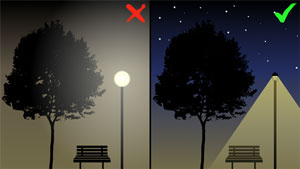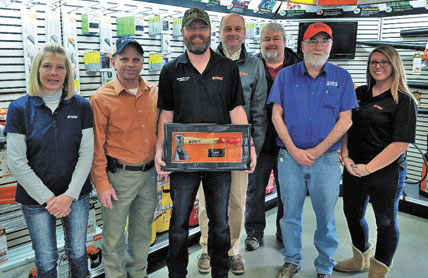February 15, 2018 • Headline News
Pick up a copy of the newspaper at your local newsstand!
UPDATED BY MARIA SIEVERDING FEBRUARY 15, 2018.
Lights out, looking up
Part two: Make thoughtful lighting choices
Jared Rogers
STAFF WRITER
Imagine you are competing on the iconic “Family Feud.” The question is, “Why do you use lights at night?” Your first response, obviously, would be something along the lines of, “To see better.” Of course, lights both inside and out aid in sight, to do all the things we like to do after dark.
A second, seemingly obvious answer might also be about safety, or deterring crime. While the show’s “survey of one hundred people” might agree, research on this issue is mixed and debatable. Some studies show that the commonly held assumption is true, in which increased lights led to decreased crime. Several also show the contrary, in which artificially lit places were more susceptible to crime. Rather than the assumed linear relationship of more lights equaling less crime, it appears conditions and context play important roles.
This simplified example is to serve as a reminder of what was introduced in part one: That more and more light does not inherently mean a better quality of life. At a certain point, too much artificial light works against us. It is reasonable to reconsider our thoughts and habits towards nighttime lighting in order to improve the health of humans, wildlife, our environment, and to protect our shared heritage of enjoying a dark, twinkling night sky.
 As for using lights wisely, the International Dark Sky Association (IDA) states simply: “A dark sky does not have to mean a dark ground.” When one decides it is necessary to use an outdoor light, here are a few recommendations:
As for using lights wisely, the International Dark Sky Association (IDA) states simply: “A dark sky does not have to mean a dark ground.” When one decides it is necessary to use an outdoor light, here are a few recommendations:1. Keep the light on only when needed
- This requires flipping on and off the switch, utilizing motion-control technology, or solar-power technology. Our local Southeastern Indiana REMC recommends motion-control style lights for overhead fixtures, while solar-powered lights work well in landscaping and walkways.
2. Only light the area that needs it
- Recall this scenario: You’re a kid, and it’s winter. You rush outside and leave the door open, with your mother following behind shouting, “Shut the door! We’re not trying to heat the whole world!” The kid doesn’t know any better, but the adult knows both the cost and futility of trying to heat endless space. The same is true for lights left on for no particular purpose, or installed in places where they are not useful; it is simply a waste.
3. Fully shield lights to direct them to the ground, while protecting the sky
- This follows from the example above. What is the sense of allowing an overhead light to shine in all directions? Direct light downwards to aid in sight and decrease waste.
4. Don’t make the light any brighter than necessary
- LED lights are now the recommended choice for outdoor lighting, replacing high-pressure sodium (HPS) or mercury vapor lamp styles, since LEDs are much more efficient. For the same amount of light, LEDs often use less than half (or even three quarters) of the energy of older bulbs. While the energy savings is positive, brighter is not always better. Depending on surrounding conditions, brighter lights may distract or strain the eye, or cast harsh shadows or glare, making for dangerous surroundings. Bright lights can extend well past property lines, too, possibly disrupting our neighbors.
5. Choose warmer (red-hued) lights rather than bright white and blue-hued lights
- The human eye perceives light along a spectrum, where “blue” emissions are naturally perceived during daylight hours, and “red” is perceived around dusk and dawn. Medical research shows clearly that artificial bright white and blue lighting has disruptive effects on sleep, which can cascade into a host of significant health issues. The same disruption occurs to nocturnal wildlife. Generalized examples include bird migration paths being thrown off course, amphibian mating and feeding behaviors becoming confused, and fatal attraction by insects.
An additional tip, regarding indoor lights: Draw the blinds and/or curtains on your windows at night to keep light inside and the outdoors dark. Doing so also increases your privacy, and in the colder months of the year, this helps minimize draft, too. Open them back up in the morning to allow natural light and solar warmth to shine through.
The IDA, alongside other organizations, are seeing success in reclaiming the wonder of the night sky. The group offers five types of “dark-sky” designations: Two deal with communities and future developments whom, through ordinance, have implemented thoughtful usage guidelines. The other three deal with parks and nature preserves that have implemented responsible lighting choices and offer accessible places for the public to enjoy the sky. Over a dozen of our national parks have received “dark-sky” designation, state parks across the country are following suit, and even conscientious communities are coming together to minimize light pollution, inviting the milky way to once again rest observably above their homes.
The gist is this: Lights at night are great to help us see, but the night sky is pretty great, too. Under it lies a multitude of interconnected living things that for millennia have relied on a natural light-dark cycle to thrive. Within our sky lie the grandest objects and forces of our universe, which deserve our humble appreciation. Such a resource is too precious to ignore and destroy.
Zimmer Tractor named Stihl Dealer of the Year
Zimmer Tractor on US 50 in Aurora has been given the distinguished honor of being named the 2017 Stihl Terrority Dealer of the Year. There are 60 dealers in the territory Zimmer is a part of, so they are proud to be named Dealer of the Year by territory representative Mike Hopkins of Bryant Equipment.
The Stihl “ambassador” at Zimmer’s Aurora location is Brian Smith. Brian and the parts team of Rich McDaniel and Dawn Waters, has continued to grow with Bryant Equipment and Stihl.
 SUBMITTED PHOTO
SUBMITTED PHOTOPictured left to right are Dawn Water, David Meyer, Stihl Ambassador Brian Smith, Mark Jankowski, director of sales for Bryant Equipment, Mike Hopkins, territory sales representative for Bryant Equipment, Rich McDaniel and Miranda Aulbach.
Brian Smith was praised for becoming a “Stihl Ambassador” for the past five years. It was noted that he keeps the showroom immaculate in its appearance and is always up on what’s currently going on with Stihl equipment. He has grown as a salesman, parts guy and “on the spot” technician fixing the computers. He shares his knowledge with other employees which helps with the Zimmer Tractor philosophy of better business.
Zimmer Tractor has seen steady growth over the past five plus decades of business. The company believes in long term relationships with their employees, which is apparent at the Aurora location.














